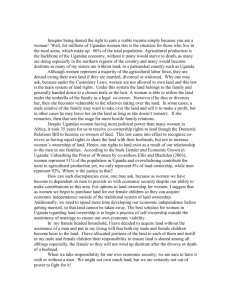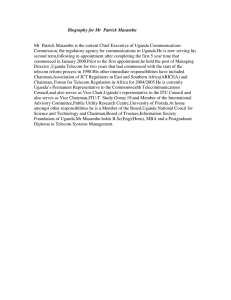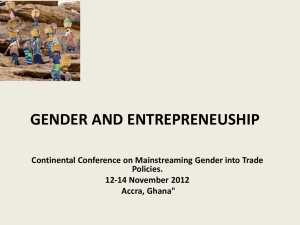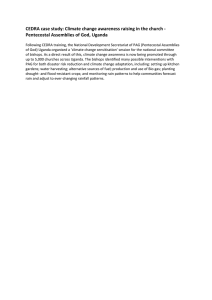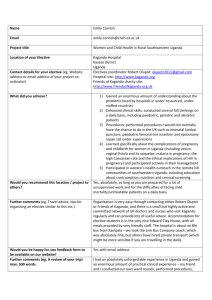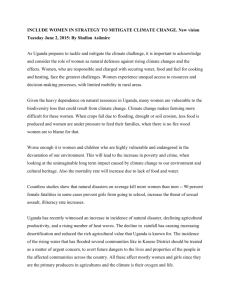Dear Sir/ Madam. Please find the contribution of the UHRC to the
advertisement
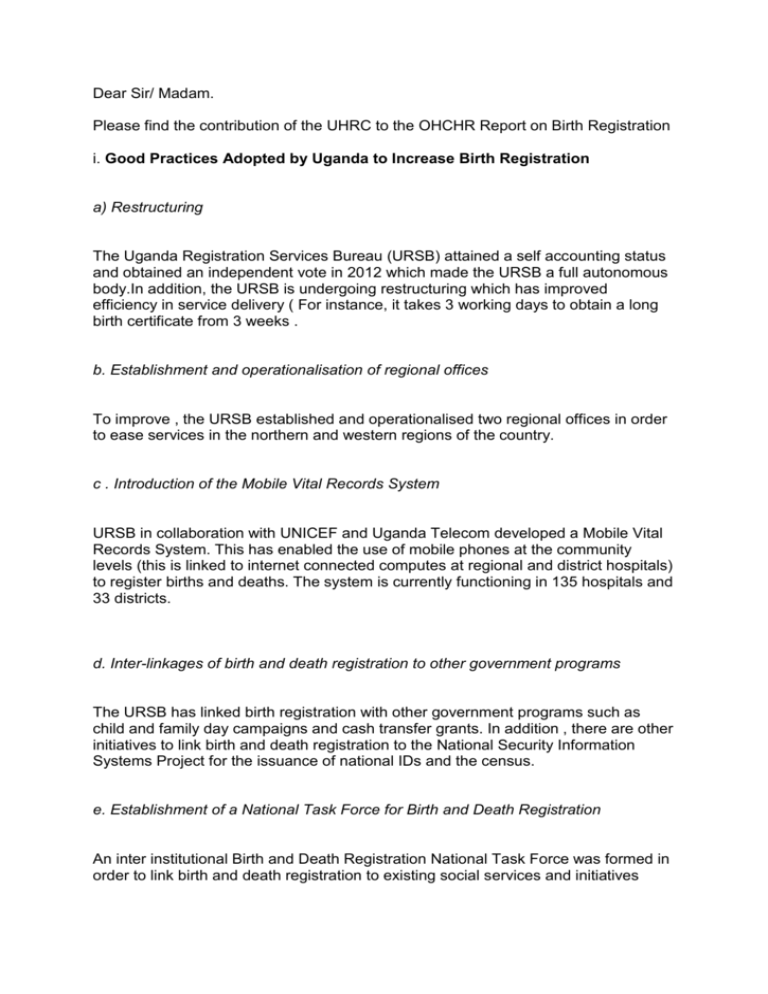
Dear Sir/ Madam. Please find the contribution of the UHRC to the OHCHR Report on Birth Registration i. Good Practices Adopted by Uganda to Increase Birth Registration a) Restructuring The Uganda Registration Services Bureau (URSB) attained a self accounting status and obtained an independent vote in 2012 which made the URSB a full autonomous body.In addition, the URSB is undergoing restructuring which has improved efficiency in service delivery ( For instance, it takes 3 working days to obtain a long birth certificate from 3 weeks . b. Establishment and operationalisation of regional offices To improve , the URSB established and operationalised two regional offices in order to ease services in the northern and western regions of the country. c . Introduction of the Mobile Vital Records System URSB in collaboration with UNICEF and Uganda Telecom developed a Mobile Vital Records System. This has enabled the use of mobile phones at the community levels (this is linked to internet connected computes at regional and district hospitals) to register births and deaths. The system is currently functioning in 135 hospitals and 33 districts. d. Inter-linkages of birth and death registration to other government programs The URSB has linked birth registration with other government programs such as child and family day campaigns and cash transfer grants. In addition , there are other initiatives to link birth and death registration to the National Security Information Systems Project for the issuance of national IDs and the census. e. Establishment of a National Task Force for Birth and Death Registration An inter institutional Birth and Death Registration National Task Force was formed in order to link birth and death registration to existing social services and initiatives such as immunization on child days , enrollment in schools and access to social grants. f. Waiver of fees for refugees to facilitate their registration The waiver of fees under the act to allow for refugees to register their children has seen an increase in registration rates of children of refugees born in Uganda. g. Public and stakeholders awareness The URSB has undertaken awareness raising country wide in order to make the public aware of the services offered. This has also included trainings at the national and regional levels ( in order to have a common understanding of the different roles and responsibilities of duty bearers) and training of trainers who will assist in registration exercise. h. Review of relevant subsidiary laws URSB is in the process of reviewing subsidiary laws in order to take birth registration services closer to the people. ii. Main Barriers to access Universal Birth Registration a. Lack of a legal , policy and institutional framework- Uganda lacks a national policy on Birth and Death Registration that outlines implementation strategies for attaining widespread coverage and universal registration.This has hindered the adoption of a comprehensive and more effective system (that continuously integrates birth registration with access to crucial public social and economic services) and the necessary civil registration reforms. In addition, the absence of a policy has had a bearing on the amendment of the 1973 Births and Deaths Registration Act which should be amended to eliminate barriers to birth registration in order to accommodate alternative methods or flexibilities. b.The current operational laws do not match or support the necessary structural improvements. The laws do not respond to changing population needs as well as country and global developments. The operations of the URSB rely heavily on Local Government Structures such as registrars who remain local government employees which in turn makes their management a challenge. ii. Administrative Barriers a) Late Registration after the expiry of 6 months calls for extensive documentation like birth notifications, sworn statements and corroborative letters from local administrative officials. In addition , different Registrars at Local Governments do not have a list of standard documents which poses a challenge for people who lack these documents. b. Lack of a national strategic plan for birth registration that identifies clear targets, indicators and a specific supervision , monitoring and evaluating plan. iii. Economic Barriers Though the URSB collects non tax revenue from registrations conducted, it is not financially self reliant because it remits all the money to the consolidated fund which poses a challenge in regard to funding and sustainability of ongoing initiatives. The URSB still faces a challenge to implement universal birth registration. iv. Cultural Barriers Traditional beliefs and taboos such as the counting of children ( there is a belief that this could lead to an omen) and preference of traditional rites of passage still pose a challenge to the implementation of birth registration. v. Physical Barriers Physical barriers such as distance still pose a challenge to the registration of births because the majority of municipal offices are still concentrated in urban areas. vi. Limited Awareness There is still limited awareness about birth registration and most people still do not understands its importance. This information was compiled with the help of the Uganda Registration Services Bureau Regards, Patricia Nduru A/ Director Monitoring and Inspections Uganda Human Rights Commission




